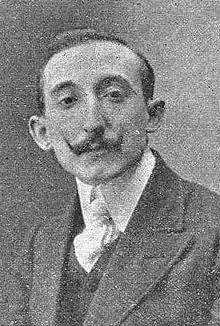Wenceslao Fernández Flórez
Wenceslao Fernández Flórez (1885 in A Coruña, Galicia – 29 April 1964 in Madrid) was a popular Galician journalist and novelist of the early 20th century. Throughout his career, he retained an intense fondness for the land of his birth.
Wenceslao Fernández Flórez | |
|---|---|
 | |
| Born | Wenceslao Fernández Flórez 1885 A Coruña, Spain |
| Died | 29 April 1964 (aged 78–79) Madrid, Spain |
| Seat S of the Real Academia Española | |
| In office 14 May 1945 – 29 April 1964 | |
| Preceded by | José Alemany y Bolufer |
| Succeeded by | Julián Marías |
Early life and career
His father died when he was fifteen years old, forcing Wenceslao to abandon his education and dedicate himself to journalism. His first job was with A Coruña's La Mañana, and he went on to write for El Heraldo de Galicia, Diario de A Coruña and Tierra Gallega. At the age of eighteen he was given a senior position at Diario Ferrolano. He later returned to A Coruña to work at El Noroeste.
He kept close friendship with Galician nationalism leaders and other intellectuals . Among his friends we find: Manuel Maria Puga and Parga -Picadillo-, Carré brothers, Tettamanci, Manuel Casas, Angel Castillo and others. All of them were older than him, but who really makes a huge impression in his way of thinking was Castelao, which was one of the most frequently illustrators for his works.
Fernández Flórez was elected to seat S of the Real Academia Española, he took up his seat on 14 May 1945.[1]
Work in Madrid and novels
In 1914 Flórez moved to Madrid, where he worked at El Imparcial and Diario ABC, where he started the parliamentary column Acotaciones de un oyente. He had begun writing novels - La tristeza de la paz (1910), La procesión de los días (1915) and Luz de luna (1915), and Volvoreta (1917).
In translation
- The Seven Pillars; translated by Sir Peter Chalmers Mitchell, London, Macmillan and co.,ltd., (1934), 288 p.
- Seduced. In: Sáenz, Paz, ed. (1988). Narratives from the Silver Age. Translated by Hughes, Victoria; Richmond, Carolyn. Madrid: Iberia. ISBN 84-87093-04-3.
Works
- The sadness of Peace (1910)
- The procession of Days (1914)
- Moonlighting (1915)
- Dimensioning of a listener (Parliamentary Chronicles, 1916)
- Volvoreta (1917), adapted into a film by José Antonio Nieves Conde in 1976
- The Devil's Eye (1918)
- Entered a Thief (1922)
- Vulgar tragedies of life (1922), an anthology of short stories
- Bluebeard's Secret (1923)
- Visions of neurasthenia (1924)
- Women's Footsteps (1924)
- The seven columns (1926)
- Immoral Story (1927)
- The man who wanted to kill (1929), adapted for the screen by Rafael Gil in 1942 with Antonio Casal ( The man who wanted to kill and again by Rafael Gil in 1970 with Tony Leblanc ( The* man who wanted to kill )
- Artificial Ghosts (1930), an anthology of short stories
- Those who did not go to war (1930)
- The evil Carabel (1931), adapted into a film by Edgar Neville in 1935, by Fernando Fernan Gomez in 1956 and Rafael Baledón in 1962
- The man who bought a car (1932)
- Knight Adventures Rogelio Amaral (1933)
- An island in the Red Sea (1938)
- The novel number 13 (1941)
- The Living Forest (1943), adapted into a film by Joseph Neches in 1945, by José Luis Cuerda in 1987 written by Rafael Azcona and Angel de la Cruz and Manolo Gomez in 2001
- The bull, the bullfighter and the Cat (1946)
- Pelegrin system (1949)
- Fireworks (1954)
- Goalkeeper in goal (1957)
References
- "Wenceslao Fernández Flórez - letra S". Real Academia Española (in Spanish). Retrieved 26 May 2023.
External links
- Works by Wenceslao Fernández-Flórez at Faded Page (Canada)